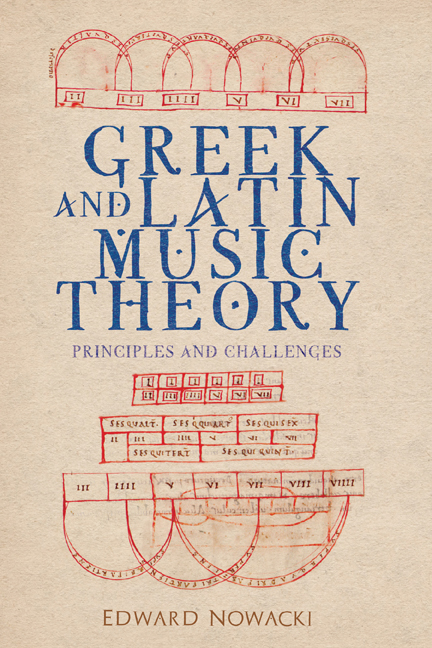5 - Boethius's Error in the De institutione musica, 4.6
Published online by Cambridge University Press: 14 August 2020
Summary
In book 4, chapter 6, of the De institutione musica, Boethius presents a method for finding the chromatic paranete (f♯’), a minor third below the highest note of the scale, that appears to be based on faulty reasoning. It offers a useful exercise for beginners in Pythagorean mathematics as well as a hint of the historiographical complexity awaiting those who choose to pursue this question as specialists. It begins as follows.
To obtain g’ (diatonic paranete), a whole tone below a’ (nete), “take an eighth part of 2,304, or 288, and add it to the same.”In other words, multiply 2,304 by (= 2,592) and obtain a string longer than the first by the ratio of 9:8. To obtain f ’ (diatonic trite), a whole tone below g’, “take an eighth part of … 2,592, which is 324, and … add it to that of which it is an eighth.” In other words, multiply the new reference point, g’, by in order to obtain the value 2,916, which measures a string longer than g’ by the ratio of 9:8. So far everything is as it should be according to Pythagorean mathematics. The note g’ is greater than a’ by and f ’ is greater than g’ by and f ’ is greater than a’ byor, the Pythagorean ditone. To obtain f♯’, the chromatic paranete, a minor third below nete, Boethius says,
If we take this distance—between the paranete hyperboleon [g’] and the nete hyperboleon [a’] of the diatonic genus—and add half of it to the paranete hyperboleon of the diatonic genus, we will get a number standing at a distance of three semitones from the nete hyperboleon. This will be the paranete hyperboleon of the chromatic genus [f♯’]. Thus I subtract 2,304, the nete hyperboleon, from 2,592, the paranete hyperboleon of the diatonic genus, and obtain a remainder of 288; I divide this by 2, which is 144; I add this to the same 2,592 and get 2,736… . This will be the chromatic paranete hyperboleon.
There are at least two errors in this procedure.
- Type
- Chapter
- Information
- Greek and Latin Music TheoryPrinciples and Challenges, pp. 56 - 59Publisher: Boydell & BrewerPrint publication year: 2020

